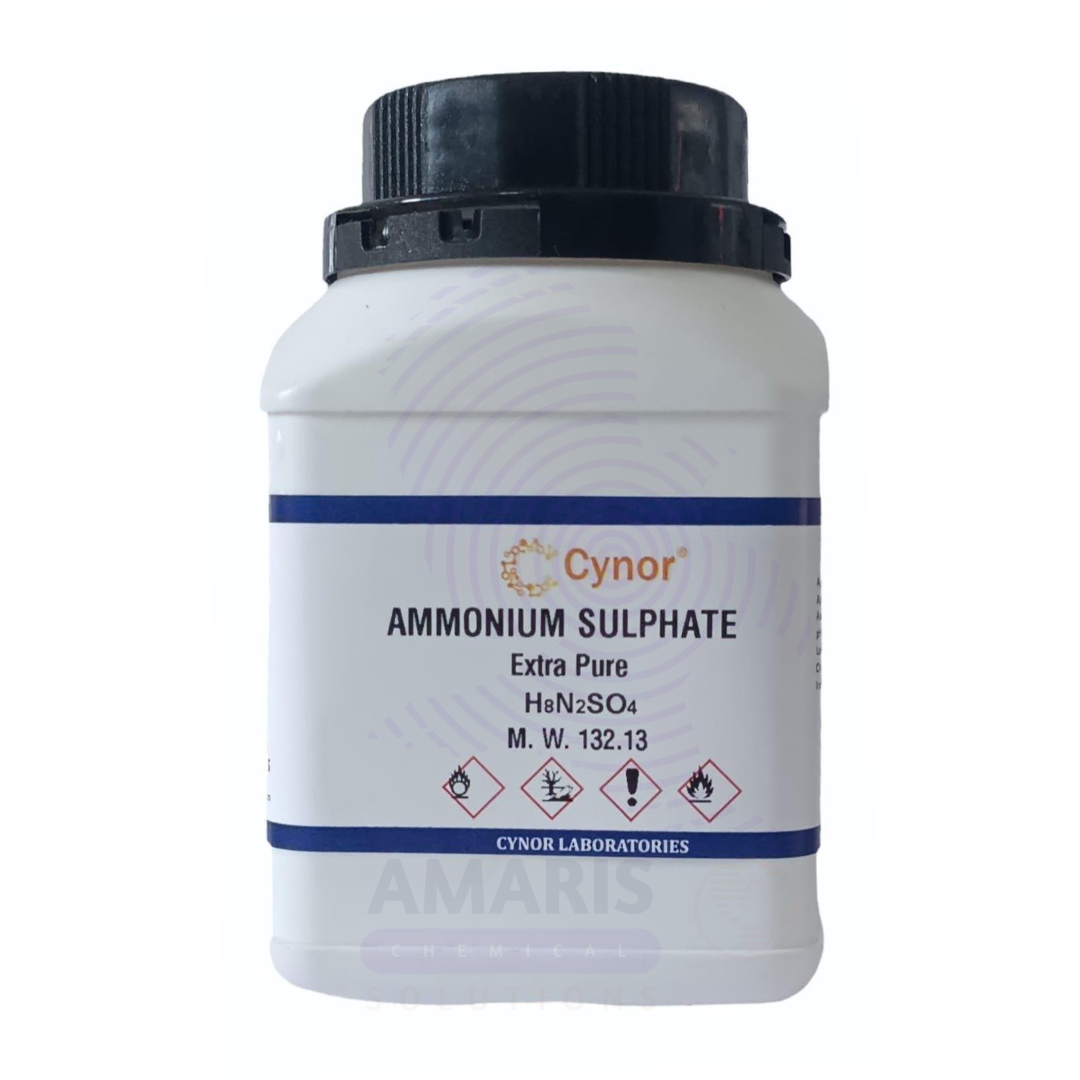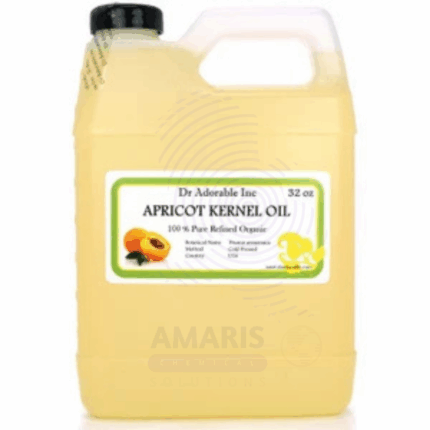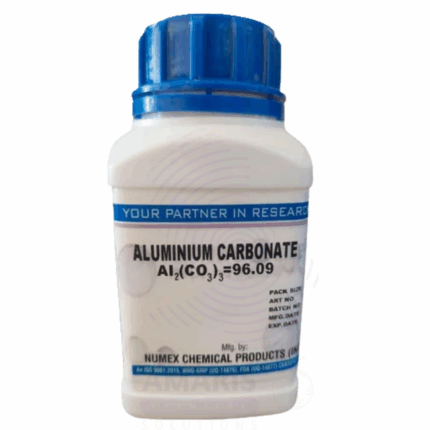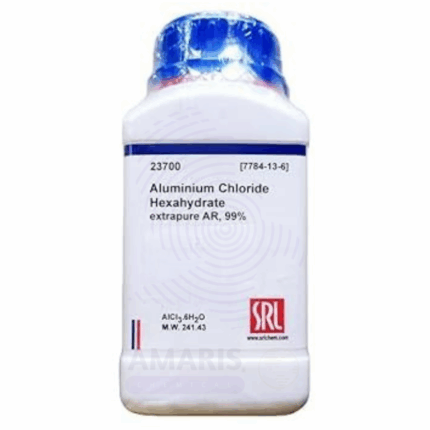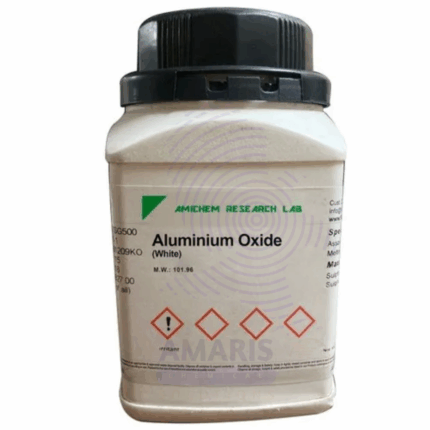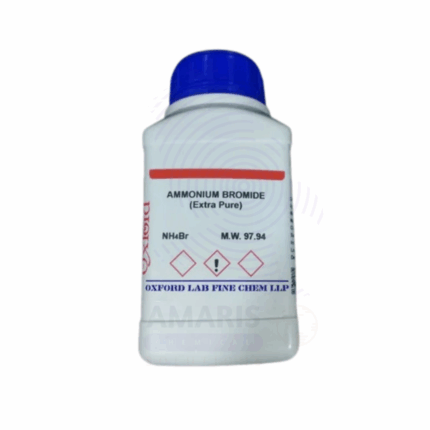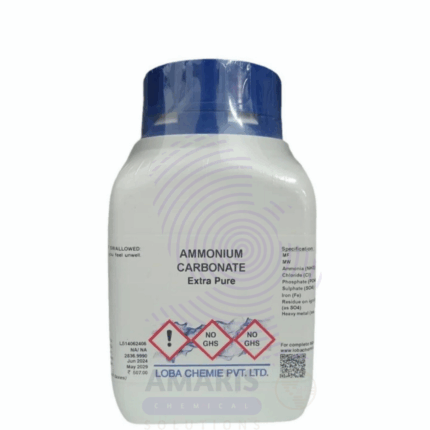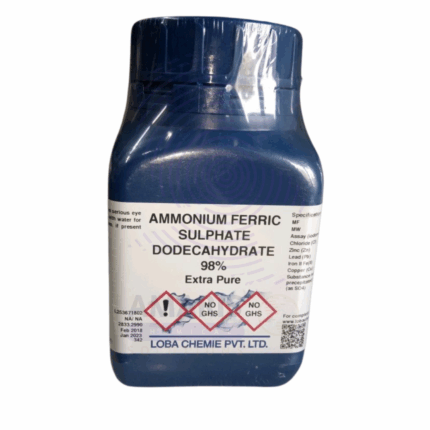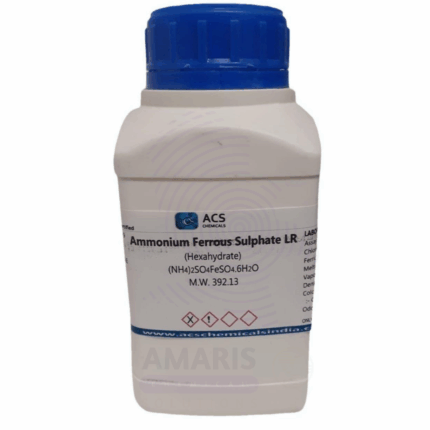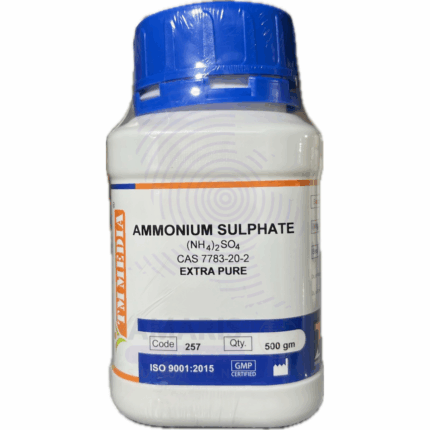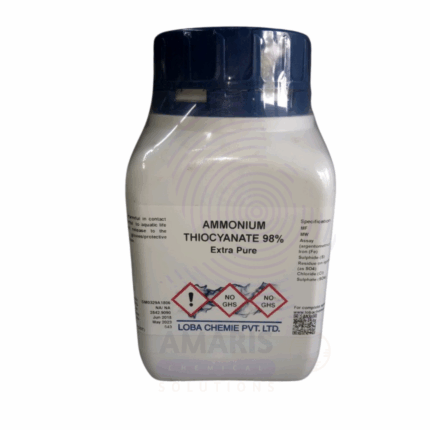
Ammonium Sulphate Extra Pure
$ 19.00 Original price was: $ 19.00.$ 18.34Current price is: $ 18.34.
Ammonium Sulphate Extra Pure is a high-purity, white crystalline compound widely used in laboratory settings for biochemical, analytical, and inorganic chemistry applications. It is especially renowned for its role in protein purification through salting-out techniques, where it helps to selectively precipitate proteins without denaturing them. In analytical chemistry, it is used as a source of ammonium and sulfate ions in standard solution preparation and as a supporting electrolyte in various reactions. Its extra pure grade guarantees minimal contaminants, making it suitable for sensitive experiments and research involving enzymes, buffers, and molecular biology. It should be stored in a tightly sealed container in a cool, dry environment to prevent caking and moisture absorption.
Ammonium Sulphate Extra Pure
Primary Uses
- Protein Precipitation via “Salting Out”
- Most common lab use — exploits decreased protein solubility at high ionic strength, allowing selective protein fractionation and purification.
- Buffering Agent and Ionic Strength Modifier
- Used in enzyme and protein assays to stabilize biomolecules and control ionic conditions.
- Reagent in Qualitative Inorganic Analysis
- Supplies NH₄⁺ and SO₄²⁻ ions for cation group analysis, and for preparing double salts and testing precipitation reactions.
- Nutrient Source in Microbiological Media
- Provides a readily available nitrogen source in defined media for bacteria, yeast, and fungi.
- Demonstration of Salt Solubility and Ionic Behavior
- Ideal for student experiments exploring colligative properties, pH effects, or crystal formation.
Secondary Uses
- Crystallization of Macromolecules (e.g., X-ray Crystallography)
- Used to grow crystals of proteins or enzymes by gradually increasing salt concentration to induce nucleation.
- Simulated Soil Chemistry and Nutrient Transport
- Applied in environmental and agricultural lab studies to model nitrogen availability and leaching behavior.
- Component in Sample Preservation and Storage Buffers
- Stabilizes proteins or enzymes by reducing water activity and microbial growth during long-term storage.
- Teaching Reagent in Thermodynamic and Equilibrium Studies
- Suitable for lab demonstrations of entropy-driven precipitation and common ion effect.
- Salt Bridge or Electrolyte in Electrochemical Cells
- Occasionally used in galvanic cell experiments to maintain ionic contact between half-cells.
| PACK SIZE |
500 grams Plastic Tin |
|---|
1. Basic Identification Attributes
- Chemical Name: Ammonium Sulphate
- CAS Number: 7783-20-2
- HS Code: 31022100 (Ammonium sulphate)
- Molecular Formula: (NH₄)₂SO₄
- Synonyms:
- Diammonium sulfate
- Sulfuric acid diammonium salt
- Mascagnite (natural mineral form)
- Ammonium sulfate
2. Physical & Chemical Properties
- Physical State: Solid (crystalline powder or granules)
- Color & Odor: White crystals; odorless
- Boiling Point: Decomposes before boiling
- Melting Point: ~235–280 °C (decomposes)
- Density/Specific Gravity: ~1.77 g/cm³
- Solubility:
- Water: Highly soluble (~75.4 g/100 mL at 20 °C)
- Alcohol: Insoluble
- pH Level: ~5.0–6.0 (in 5% aqueous solution; mildly acidic)
- Vapor Pressure: Negligible
- Flash Point: Not flammable
- Autoignition Temperature: Not applicable
- Viscosity: Not applicable
3. Safety & Hazard Attributes
- Hazard Class (GHS):
- Not classified as hazardous under GHS
- May cause mild eye or respiratory irritation if dust is inhaled
- NFPA Ratings:
- Health: 1
- Flammability: 0
- Reactivity: 0
- Exposure Limits:
- No specific OSHA/ACGIH limits; general dust limits apply
- Reactivity:
- Stable under normal conditions
- Incompatible with strong bases and oxidizing agents
4. Storage & Handling Attributes
- Storage Conditions:
- Store in a cool, dry, well-ventilated area
- Keep container tightly closed to prevent moisture uptake
- Incompatible Materials:
- Strong oxidizers, alkalis, nitrates
- Container Type:
- Plastic or glass containers with airtight seals
- Shelf Life & Expiration Date:
- ~3–5 years in dry, sealed storage
- Special Handling Requirements:
- Use gloves, lab coat, goggles
- Minimize dust generation; handle in ventilated space if large amounts used
5. Regulatory & Compliance Attributes
- Regulatory Status:
- Listed in TSCA, REACH
- Also used in food, pharmaceutical, and agricultural grades (not lab-specific)
- Hazard Symbols (GHS Pictograms):
- None required for laboratory-grade use
- Transportation Restrictions:
- Not classified as hazardous material for transport
- Waste Disposal Method:
- Dilute and dispose of via laboratory wastewater system
- Avoid large-scale disposal into aquatic environments
6. Environmental & Health Impact
- Ecotoxicity:
- Can contribute to eutrophication in aquatic environments
- Persistence in Environment:
- Dissociates to ammonium and sulfate ions; may alter soil and water chemistry
- Carcinogenicity/Mutagenicity:
- Not classified as carcinogenic or mutagenic
- Biodegradability:
- Inorganic; not biodegradable but naturally occurring and assimilable
SAFETY PRECAUTIONS
- Personal Protective Equipment (PPE):
- Wear lab coat, safety goggles, and chemical-resistant gloves (e.g., nitrile).
- Use in a well-ventilated area or under a fume hood to avoid dust inhalation.
- Handling:
- Handle with care to avoid forming dust.
- Avoid inhalation, ingestion, and contact with skin or eyes.
- Do not mix with strong alkalis or oxidizing agents.
- Storage:
- Store in a tightly closed container in a cool, dry, well-ventilated area.
- Protect from moisture—the salt is hygroscopic.
- Keep away from acids and incompatible substances.
- Hygiene Measures:
- Wash hands thoroughly after handling.
- Do not eat, drink, or smoke in the lab.
- Clean all equipment and surfaces after use.
FIRST AID MEASURES
- Inhalation:
- Move to fresh air immediately.
- If symptoms like coughing or breathing difficulty occur, seek medical attention.
- Use oxygen if necessary.
- Skin Contact:
- Wash skin with plenty of water and soap.
- Remove contaminated clothing.
- Seek medical attention if irritation develops.
- Eye Contact:
- Flush eyes with clean water for at least 15 minutes.
- Hold eyelids apart to ensure thorough rinsing.
- Seek medical advice if irritation persists.
- Ingestion:
- Rinse mouth thoroughly with water.
- Do not induce vomiting.
- If conscious, give water to dilute.
- Seek medical attention if large amounts are swallowed.
FIRE FIGHTING MEASURES
- Suitable Extinguishing Media:
- Use dry chemical, carbon dioxide (CO₂), foam, or water spray, depending on the surroundings.
- Specific Hazards:
- Not flammable, but may decompose at high temperatures to release:
- Ammonia
- Sulfur oxides (SOₓ)
- Nitrogen oxides (NOₓ)
- Not flammable, but may decompose at high temperatures to release:
- Protective Equipment for Firefighters:
- Wear self-contained breathing apparatus (SCBA) and full protective gear.
- Firefighting Instructions:
- Cool exposed containers with water spray.
- Avoid inhalation of thermal decomposition products.
- Contain runoff to prevent environmental contamination—may be harmful to aquatic life in high concentrations.
Related products
Aluminium Carbonate Extra Pure
Aluminium Chloride Hydrated Extra Pure
Aluminium Oxide Extra Pure
Ammonium Bromide Extra Pure
Ammonium Carbonate Extra Pure
Ammonium Carbonate Extra Pure is a high-quality, white crystalline solid widely used across various scientific, industrial, and food-related applications. Manufactured to stringent purity standards, this compound is ideal for laboratories and processes that demand high-grade reagents. With its characteristic ammonia-like odor and ability to decompose upon heating, ammonium carbonate plays a versatile role in both chemical reactions and physical processes.
In aqueous solution, ammonium carbonate breaks down into ammonium bicarbonate and ammonium carbamate, further releasing ammonia (NH₃) and carbon dioxide (CO₂) upon heating. This property makes it especially useful in applications that require controlled gas release or temporary pH modification.


 Preservatives(food)
Preservatives(food) Flavor Enhancers
Flavor Enhancers Acidulants
Acidulants Sweeteners
Sweeteners Antioxidants
Antioxidants Colorants(food)
Colorants(food) Nutraceutical Ingredients (food)
Nutraceutical Ingredients (food) Nutrient Supplements
Nutrient Supplements Emulsifiers
Emulsifiers
 Collectors
Collectors Dust Suppressants
Dust Suppressants Explosives and Blasting Agents
Explosives and Blasting Agents Flocculants and Coagulants
Flocculants and Coagulants Frothers
Frothers Leaching Agents
Leaching Agents pH Modifiers
pH Modifiers Precious Metal Extraction Agents
Precious Metal Extraction Agents
 Antioxidants(plastic)
Antioxidants(plastic) Colorants (Pigments, Dyes)
Colorants (Pigments, Dyes) Fillers and Reinforcements
Fillers and Reinforcements Flame Retardants
Flame Retardants Monomers
Monomers Plasticizers
Plasticizers Polymerization Initiators
Polymerization Initiators Stabilizers (UV, Heat)
Stabilizers (UV, Heat)
 Antifoaming Agents
Antifoaming Agents Chelating Agents
Chelating Agents Coagulants and Flocculants
Coagulants and Flocculants Corrosion Inhibitors
Corrosion Inhibitors Disinfectants and Biocides
Disinfectants and Biocides Oxidizing Agents
Oxidizing Agents pH Adjusters
pH Adjusters Scale Inhibitors( water)
Scale Inhibitors( water)
 Antioxidants(cosmetic)
Antioxidants(cosmetic) Emollients
Emollients Fragrances and Essential Oils
Fragrances and Essential Oils Humectants
Humectants Preservatives
Preservatives Surfactants(cosmetic)
Surfactants(cosmetic) Thickeners
Thickeners UV Filters
UV Filters
 Fertilizers
Fertilizers Soil Conditioners
Soil Conditioners Plant Growth Regulators
Plant Growth Regulators Animal Feed Additives
Animal Feed Additives Biostimulants
Biostimulants Pesticides (Herbicides, Insecticides, Fungicides)
Pesticides (Herbicides, Insecticides, Fungicides)
 Active Pharmaceutical Ingredients (APIs)
Active Pharmaceutical Ingredients (APIs) Excipients
Excipients Solvents(pharmaceutical)
Solvents(pharmaceutical) Antibiotics
Antibiotics Antiseptics and Disinfectants
Antiseptics and Disinfectants Vaccine Adjuvants
Vaccine Adjuvants Nutraceutical Ingredients (pharmaceutical)
Nutraceutical Ingredients (pharmaceutical) Analgesics & Antipyretics
Analgesics & Antipyretics
 Analytical Reagents
Analytical Reagents Solvents(lab)
Solvents(lab) Chromatography Chemicals
Chromatography Chemicals Spectroscopy Reagents
Spectroscopy Reagents microbiology-and-cell-culture-reagents
microbiology-and-cell-culture-reagents Molecular Biology Reagents
Molecular Biology Reagents Biochemical Reagents
Biochemical Reagents Inorganic and Organic Standards
Inorganic and Organic Standards Laboratory Safety Chemicals
Laboratory Safety Chemicals Specialty Laboratory Chemicals(Special Laboratory Equipment)
Specialty Laboratory Chemicals(Special Laboratory Equipment)
 Demulsifiers
Demulsifiers Hydraulic Fracturing Fluids
Hydraulic Fracturing Fluids Scale Inhibitors(oil)
Scale Inhibitors(oil) Surfactants(oil)
Surfactants(oil) Drilling Fluids
Drilling Fluids
 Dyes and Pigments
Dyes and Pigments Bleaching Agents
Bleaching Agents Softening Agents
Softening Agents Finishing Agents
Finishing Agents Antistatic Agents
Antistatic Agents
 Admixtures
Admixtures Waterproofing Agents
Waterproofing Agents Sealants and Adhesives
Sealants and Adhesives Curing Compounds
Curing Compounds Concrete Repair Chemicals
Concrete Repair Chemicals Anti-Corrosion Coatings
Anti-Corrosion Coatings
 Surfactants(cleaning)
Surfactants(cleaning) Builders
Builders Enzymes
Enzymes Solvents (Cleaning)
Solvents (Cleaning) Fragrances
Fragrances
 Electronic Chemicals
Electronic Chemicals Catalysts
Catalysts Lubricants
Lubricants Photographic Chemicals
Photographic Chemicals Refrigerants
Refrigerants Automotive chemicals
Automotive chemicals Pyrotechnic Chemicals
Pyrotechnic Chemicals
 Biodegradable Surfactants
Biodegradable Surfactants Bio-based Solvents
Bio-based Solvents Renewable Polymers
Renewable Polymers Carbon Capture Chemicals
Carbon Capture Chemicals Wastewater Treatment Chemicals
Wastewater Treatment Chemicals
 Pigments
Pigments Solvents(paint)
Solvents(paint) Specialty Coatings
Specialty Coatings Binders/Resins
Binders/Resins Additives
Additives Driers
Driers Anti-Corrosion Agents
Anti-Corrosion Agents Functional Coatings
Functional Coatings Application-Specific Coatings
Application-Specific Coatings
 Fresh Herbs
Fresh Herbs Ground Spices
Ground Spices Whole Spices
Whole Spices Spice Blends
Spice Blends Dried Herbs
Dried Herbs
 Leavening Agents
Leavening Agents Dough Conditioners
Dough Conditioners Flour Treatments
Flour Treatments Fat Replacers
Fat Replacers Decoratives
Decoratives Preservatives(baking)
Preservatives(baking)
 Plasticizers & Softeners
Plasticizers & Softeners Reinforcing Agents
Reinforcing Agents Adhesion Promoters
Adhesion Promoters Vulcanizing Agents
Vulcanizing Agents Antidegradants
Antidegradants Blowing Agents
Blowing Agents Fillers & Extenders
Fillers & Extenders Accelerators & Retarders
Accelerators & Retarders